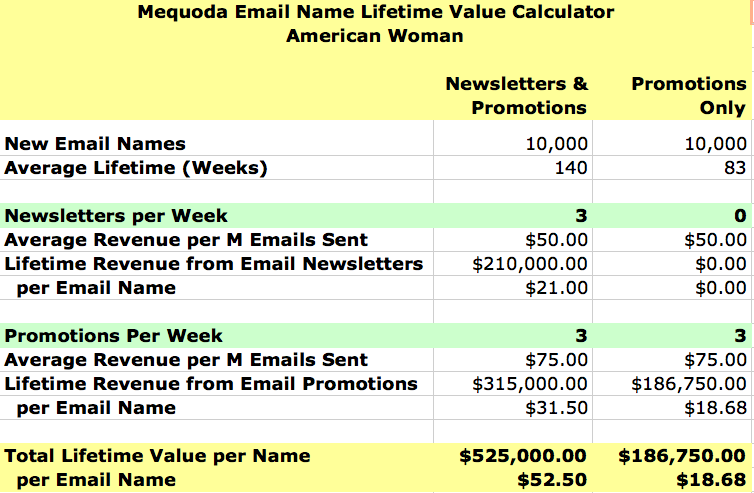 Online Marketing Tools: Using an Email Lifetime Value Calculator to measure the real lifetime value of an email name
Online Marketing Tools: Using an Email Lifetime Value Calculator to measure the real lifetime value of an email name
The essence of the Mequoda System is to build a database of email newsletter subscribers, send them valuable free content, build your brand, earn trust, and eventually monetize these email subscribers by selling them paid products and services.
It’s a simple strategy: Make online friends, give away tips and tools, achieve top-of-mind awareness, and ultimately make sales.
Even so, some print publishers just “don’t get it.”
I’m still appalled at the number of publishers who never send out valuable free content, preferring to use email solely to promote their paid magazines, newsletters, books and seminars.
They do little or no editorial support, brand building, or trust building by giving away useful content online. Instead, they rely entirely on consumer trust in a brand they have built in print, or established in a brick and mortar world, to credential their online sales promotion message.
This tactic can succeed, but only up to a point.
The Mequoda System offers publishers a much better, much more profitable online marketing strategy.
Little-known fact: If you send out an equal number of (1) content-rich email newsletters and (2) straight product promotions versus sending only promotions, the length of time you’ll retain an active email name will almost double.
Again: The active lifetime of an email name almost doubles when you email an equal number of (1) free editorial newsletters and (2) product promotions instead of sending only promotions.
[text_ad]
It’s true. In testing we did over multiple years, the average term of an email newsletter subscriber was 2.7 years when the ratio of valuable free content and promotional messages is 50/50, versus an average lifetime of 1.6 years for email names who were sent only promotional messages.
These results have been proven with long, expensive, time-consuming tests.
By doubling the contact frequency — provided that half the emails include valuable editorial content — the recipient will choose to remain active for almost twice as long before opting out.
Now consider the possibilities: In this hypothetical example for the fictitious American Woman magazine, you could send out three promos per week, for an average email name lifetime of 83 weeks, for a total of 249 email promotions mailed, with an average return of $75 per thousand names.
Alternatively, you could mail the average email subscriber three promos per week, for an average lifetime of 140 weeks, still averaging a return of $75 per thousand names.
Of course, in order to achieve that additional 57 weeks of contact, you need to commit to sending an additional three email newsletters each week, and generating another $50 per thousand names with the newsletters.
Sending only promotions results in email names that stay on the file for only an average of 83 weeks and generate an average of $18.68 per name.
But if you follow the Mequoda System, and commit to an email publishing strategy, sending three content-rich email newsletters each week, plus three promotions each week, the average subscriber name is worth $52.50 over their average 140-week lifetime.
[text_ad]
How to triple your online revenue by sending email newsletters and promotions
Consider the economic considerations for using your email file for promotions only vs. using your email file to also send content rich newsletters.
Let’s assume you have a large print subscriber list, which you can use to create an email subscriber file that will generate revenue. To create the file, you might use a data enhancement service such as Melissa DATA to append email addresses to the postal address database of your print subscribers.
What will you do with your new email subscriber file? Will you simply send out three promos per week for your own products? Or will you treat email as a separate publishing platform, sending three email newsletters and three promos per week to your active email database?
The economics are simple. In scenario #1, if you choose to send promos only, in our example above, you’ll generate an average of $18.63 per email name over the 83-week average lifetime of a new email name and you’re done.
In scenario #2, if you send both three email newsletters and three promos, in our example above, each new name on the file will be worth an average of $52.50 over their average 140-week lifetime.
Of course, scenario #2 requires greater resources. Sending email newsletters three times per week requires the skills of a talented online editor who skilled at both service journalism and direct response online copywriting.
For every new 10,000 names, scenario #1 generates $186,750 in lifetime revenue. Scenario #2 generates $525,000. The difference is $338,250. That’s a tidy sum that can buy a great deal of copywriting and editing expertise, with money left over to turn a profit.
Note: The most successful Mequoda System operators almost always employ copywriters who earlier in their careers were journalists. This copywriter/journalist hybrid must understand “journalism with a motive,” whose objective is to sell products and services.
Conclusion: Email newsletter publishing is far more profitable that simple email newsletter marketing.
Want to learn more about how to grow your email revenue…how to repurpose your paid content into other products such as blogs, membership websites and podcasts for new revenue opportunities…how to achieve higher search engine rankings…how to make more money online?
Join Kim, Amanda and me at the Mequoda Summit to discover the strategies, tactics and best practices for growing a successful online business using the Mequoda System in a Web 2.0 world.
Time is running out. Register for the Mequoda Summit today.
By the way, the Mequoda Email Name Lifetime Value Calculator is one of a dozen tools you’ll receive at the Mequoda Summit or when you become a Mequoda Pro Charter Member.



